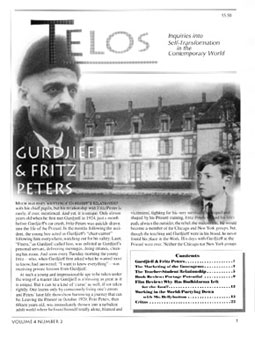|
The Gurdjieff Journal
Back Issue - #14 Volume 4 Issue 2

|
Gurdjieff & Fritz Peters
|
Fritz Peters was only 11 years old when he met Gurdjieff at the Prieure in June 1924. The following month the young boy became Gurdjieff's
"chair-carrier," following him around the grounds of the chateau, watching out for his safety. Later, "Freets," as Gurdjieff called him,
acted as Gurdjieff's personal servant, delivering messages, doing errands, cleaning his room. And soon every Tuesday morning the young
Fritz—who, when Gurdjieff first asked what he wanted most to know, had answered: "I want to know everything"—was receiving
private lessons from Gurdjieff.
|
|
How The Enneagram Came to Market
|
Enneagram associations offer tapes, videos, study groups, certification courses and workshops.
Newsletters and monthly newspapers have also sprung up running articles such as "The Ennea-style,"
which features an analysis of how clothing relates to various personalities of the enneagram.
Meanwhile businesses use the enneagram as a hiring tool and, according to Newsweek, the CIA
uses it to train its agents. Some Hollywood and TV scriptwriters are building their plots around it.
Lost in all this buzz is the recognition that the enneagram is an esoteric symbol having many levels
of meaning, that it is an integral part of the ancient teaching Gurdjieff brought and could not be
understood or used appropriately outside the teaching.
|
|
The Teacher-Student Relationship
|
The form and substance of the teacher-student relationship is archetypal. Truly formed,
the relationship opens the student to new life and possibilities, but in doing so, it first
evokes a collision of worlds—a collision of the objective with the subjective, the time-free
with the time-bound, the real with the unreal. Friction, confusion, clash and rebellion
must result.
The stronger the student, the stronger this struggle. This is seen most vividly in the
relationship G.I. Gurdjieff had with Ouspensky and Orage. Both students were blessed with
a great intellect and thirst for knowledge. Powerful in ordinary life, confident of their abilities,
neither was easy to impress or to lead. They demanded a great deal of Gurdjieff. And he of them.
|
|
Book Review:
Portage Potential
by Jean Toomer
|
Jean Toomer had led groups in Chicago for about five years when he decided to conduct
an important next step: his "experiment" at Portage in the Wisconsin countryside. There he
would live with his students under special conditions where those who wanted to change would
not only be helped to change but made to change.
Portage Potential, his unpublished book, written in 1932, describes two months in the
summer of 1931, in which four to twelve people lived together in a cottage, cooking, cleaning,
interacting, and playing games. It gives a glimpse of what it is like to live with a group of
people whose common aim is to wake up. While he seldom refers to Gurdjieff, Toomer admits that
the underpinnings of his ideas are taken directly from Gurdjieff, but he makes it clear that
the book is not an attempt to reformulate Gurdjieff's ideas. "None of this would have been
possible," says Toomer, "without what Mr. Gurdjieff has done for me—but I am an imperfect
understander and transmitter."
|
|
Film Review:
Why Has Bodhi Dharma Left for the East?
|
Why Has Bodhi Dharma Left for the East? is the first film by Korean filmmaker Bae Yong-Kyun.
Like Kurasawa's Rashomon, it uses multiple points of view of the three principal characters, who live
in a Korean Zen monastery: Hyegok, the teacher; Kibong, a student; and Haejin, an orphan child living
with the monks; and also a blue jay who follows and watches Haejin throughout the film. The different
points of view are woven together so tightly that the viewer is often in question as to whose point of view is being shown.
|
|
Working in the World:
Partying Down with Mr. Bellybutton
|
Gurdjieff was quite familiar with America, having visited it nine times. While he
believed that "there remains among them [Americans] the largest percentage of beings
in whose presences the said possibility [for the acquisition of Being] is not entirely
lost," he also warned that stomach and sexual disorders were Americans' chief weaknesses.
|
|
Critas
|
Tidbits gleaned from the world and the Work.
|
|
Back Issues are currently not for sale.
|
|